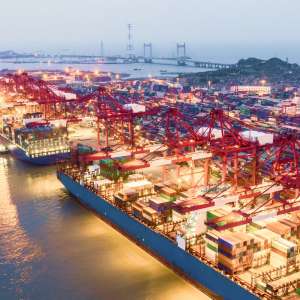Shipping from Port of Shanghai to Vietnam
Complete Guide
Latest update on 12 June, 2024 by Aurora Park– Marketing Analyst at FreightAmigo
Shipping from the Port of Shanghai to Vietnam is a crucial link in the global market, facilitating trade between China and Vietnam. Our guide provides comprehensive information on shipping methods, documentation, customs procedures, and efficient practices for a smooth transit. It equips shippers, logistics managers, and businesses with the knowledge needed to navigate this important supply chain route with confidence.
Want To Compare The Best Express, Air Freight, Sea Freight, Rail Freight & Trucking Rates So As To Have Better Control On Cost?
Shipping Methods from Port of Shanghai to Vietnam
Shipping from the Port of Shanghai to Vietnam can be conducted through various methods, each with its own advantages depending on the nature of the goods and the urgency of delivery. The primary options include sea freight, airfreight, and express courier services.
- Sea Freight: This is the most economical choice for large or heavy shipments. Options such as Less than Container Load (LCL) and Full Container Load (FCL) cater to different shipment sizes, with major routes like Shanghai to Ho Chi Minh City offering competitive rates and transit times typically ranging from 10-14 days.
- Airfreight: Best suited for high-value or perishable items that require quick delivery. Although more costly, airfreight from Shanghai can reach Vietnamese destinations like Ho Chi Minh City or Hanoi in just 1-2 days.
- Express Courier Services: This is the fastest option, with door-to-door delivery times as short as 8-10 hours. Ideal for time-sensitive documents or small parcels.
Each method has its trade-offs between cost, speed, and volume, making it crucial to select based on specific shipment needs.
Required Documentation and Customs Procedures
When shipping from the Port of Shanghai to Vietnam, ensuring all necessary documentation is in order is crucial for a smooth customs clearance process. Key documents include:
- DHL Waybill or Label: Attach a fully completed waybill to each shipment piece. Each waybill should have a unique number for tracking from collection to delivery.
- Commercial or Pro Forma Invoice: Essential for assessing duties and taxes. It should detail complete commodity information to aid customs authorities.
- Bill of Lading: This document verifies the receipt and shipment of goods. It’s crucial for sea freight and air freight.
- Certificate of Origin: Validates the manufacturing country of the goods, necessary for customs clearance.
- Packing List: Lists all items being shipped, ensuring all contents are accounted for during customs checks.
- Test or Inspection Certificates: Required for specific goods like pharmaceuticals, confirming compliance with safety standards.
Additionally, Vietnam’s customs procedures involve stages like entering information into the system, goods assessment, and obtaining necessary permits. Compliance with these steps, alongside accurate and complete documentation, is essential to avoid delays or additional charges.
Tips for Efficient Shipping from Port of Shanghai to Vietnam
To optimize shipping from the Port of Shanghai to Vietnam, consider these practical tips:
- Select the Right Shipping Mode: Depending on the urgency and type of goods, choose from express shipping, airfreight, or sea freight. Express shipping is fastest but suitable for lighter, less bulky items. Airfreight is ideal for high-value goods requiring swift delivery, while sea freight offers cost-effectiveness for heavier shipments.
- Plan for Customs and Regulations: Familiarize yourself with both countries’ customs regulations and ensure all shipping documents are accurate and complete to avoid delays.
- Use Reliable Freight Forwarders: Engage experienced freight forwarders like DFH Global Logistics, which can handle logistics efficiently and offer competitive rates.
- Consider Timing and Costs: Be aware of peak seasons and holidays like Chinese New Year, which can affect shipping times and costs. Planning shipments during off-peak periods can save time and expenses.
- Optimize Packaging: Ensure goods are well-packed and labeled correctly to prevent damage and facilitate smooth customs clearance.
By implementing these strategies, businesses can enhance the efficiency of their shipping processes from China to Vietnam, ensuring timely delivery and cost savings.
Conclusion
This guide provides valuable insights into shipping from the Port of Shanghai to Vietnam, covering logistics, customs, and transportation modes. It offers essential information on efficient shipping methods, necessary documentation, and strategic considerations for a smoother trade route. By understanding sea freight, airfreight, and express courier services, businesses can make informed decisions based on their timelines and budgets. Successful international trade relies on meticulous planning and reliable logistics partnerships. Enhancing the shipping process is crucial for achieving this. The alliance with experienced freight forwarders like FreightAmigo can significantly lighten the logistical load, providing not only peace of mind but also the promise of competitive rates and expert handling. Embracing these insights and strategies will not only facilitate a smoother journey from Shanghai to Vietnam but also bolster the efficiency and reliability of the global supply chain.
If You Wish To Ship From Port of Shanghai to Vietnam, Please Go To The FreightAmigo Page For Inquiries
Read more:
World Environment Day 2024 | Sustainable Practices in Logistics industry | FreightAmigo
A Comprehensive Guide to Pick and Pack Processes | FreightAmigo
How eCommerce Financing is Revolutionized by Technology | FreightAmigo
If you have any inquiries on logistics / supply chain, feel free to contact FreightAmigo now:
Chat with us online | Hotline: +852 28121686 | WhatsApp: +852 27467829









































